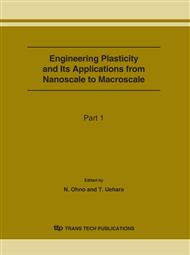p.389
p.397
p.403
p.409
p.415
p.421
p.429
p.435
p.441
Compressive Properties of Porous Metals with Homogeneous Pore Characteristics
Abstract:
Spacer method is excellent technique of processing porous metals with well-controlled pore characteristics such as porosity (up to 90%) and pore size (as small as several hundred micrometers). Compressive properties of porous aluminum fabricated by the spacer method are investigated. They were subjected to monotonic compression tests at room temperature, and showed less fluctuated flow stress during their compressive deformation than conventional porous aluminum alloy, reflecting their homogeneous pore characteristics. Also, shortening behavior of the porous aluminum fabricated by the spacer method during cyclic compression was significantly differed from that of conventional porous aluminum alloy. Therefore, it can be concluded that the homogeneity of pore characteristics is responsible for compressive properties of porous metals. Monotonic compression tests on porous copper specimens with various porosities, which were made by the spacer method, were also conducted. The yield stress of the porous copper with high porosity (or low relative density) depended on the relative density more strongly than that of the porous copper with low porosity (or high relative density). It is presumed that porous metals with high porosity and ones with low porosities have different deformation mechanisms.
Info:
Periodical:
Pages:
415-420
Citation:
Online since:
June 2007
Price:
Сopyright:
© 2007 Trans Tech Publications Ltd. All Rights Reserved
Share:
Citation:


